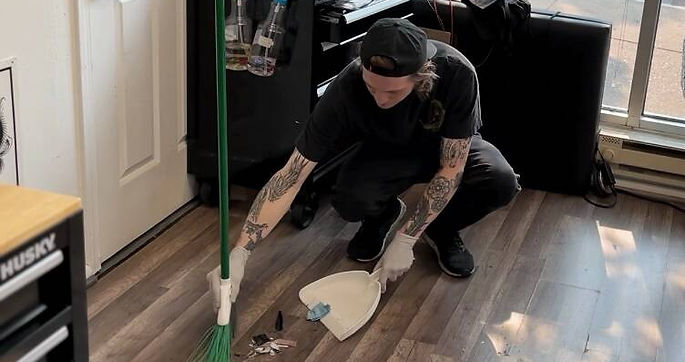Start by getting Tattooed
Being a client first shows your interest and commitment to tattooing. It helps you build relationships with the shop and the tattoo artists, creating valuable connections. This experience also allows you to network and assess whether tattooing is truly something you want to dedicate your life to.

Know What To Expect
Tattooing is a serious commitment that requires hard work, patience, and a deep respect for the craft. There is no quick results
It all begins with the grunt work like cleaning, running errands, and answering phones to demonstrate your dedication. As you progress, you’ll spend time drawing and painting to refine your skills. Understanding tattoo history is just as important, as it helps you appreciate the craft and its cultural impact.

Walk Before You Run
1. Start with the Smallest Tasks
-
Show Up Consistently: Your journey begins with showing up and demonstrating your commitment. Start with essential but unglamorous tasks like running errands, answering phones, and performing extensive cleaning. These small tasks are crucial for earning respect, proving your dedication, and forming good habits.

Simplicity is the Ultimate Form of Sophistication
2. Draw, Trace, Paint
-
Draw and Paint Relentlessly: Once you’ve handled the foundational tasks, your focus will shift to intensive drawing and painting. This is where you’ll develop your artistic skills and style. Expect to spend countless hours perfecting your craft and filling sketchbooks with designs.
-
Embrace Tattoo History: Tattooing is not just about creating art; it’s about understanding and respecting its rich history. Studying tattoo history helps you appreciate the craft’s cultural significance. This deep knowledge informs your work and connects you to the broader tradition of tattooing.

Craftsmanship is a Quality That Some Lack
3. Learn the Tools of the Trade
-
Understand the Tools: With your art skills in place and your historical knowledge established, you’ll start learning about the tools used in tattooing. Understanding tattoo machines, needles, and inks is essential for moving forward.

-
Practice with the Tools: After gaining an understanding of the equipment, you’ll begin practicing with it. This stage is about building proficiency and confidence with the tools, but it’s still a period of learning and growth.

Marks of Meaning
4. Progress to Supervised Tattooing
-
Earn Your Place: After you’ve invested time in learning and practicing, you’ll start tattooing clients under supervision. Your mentor will guide you through your initial tattoos, ensuring you apply your skills correctly and safely.

Grow
5. Welcome and Learn from Critiques
-
Expect Brutal Honesty: Throughout your apprenticeship, you’ll receive critiques on various aspects of your work from phone etiquette, client interactions, compositions, and quality of tattoos. These critiques can be brutal, but they are crucial for your development.
-
Apply Feedback: Use every piece of feedback to improve. Each critique is a chance to refine your skills and deepen your understanding of the craft.
Our program is registered with the state of Oregon and meets all requirements to become a licensed tattoo artist. It combines state-approved training with a hands-on apprenticeship and one-on-one mentorship.
We only accept students who demonstrate commitment and a willingness to consistently show up and work. The program provides the skills and experience needed to pursue a professional tattoo career.
Have Any Questions?
We’re happy to help. Reach out and let us know if we can help you with anything.


